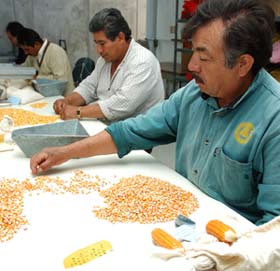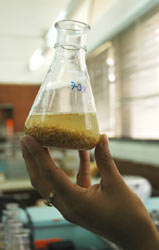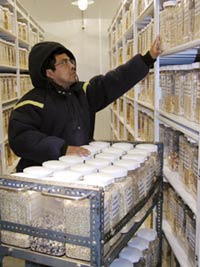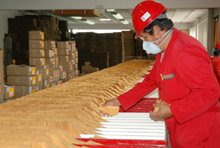Scientists uncover DNA sequence of key wheat disease resistance gene
A global team of researchers that includes CIMMYT scientists has uncovered the molecular basis of a “wonder” gene that, in tandem with other resistance genes, has helped protect wheat from three deadly fungal diseases for more than 50 years, providing farmers benefits in excess of USD five billion in harvests saved.
Since the 1970s farmers have used wheat varieties that are resistant to leaf rust, a major fungal crop disease. Without these rust-resistant varieties, wheat farmers would have lost USD 5.36 billion in harvests. [Economics Program Paper 04-01] Now, a study in this month’s issue of the renowned Science journal has reported the sequencing of Lr34—a key gene underlying this “durable” resistance in wheat to leaf rust and to two other major diseases of the crop: stripe rust and powdery mildew. Until now, no one knew much about Lr34‘s physiological action. Uncovering its DNA sequence allowed the scientists to understand how the gene works.
“Combined with other minor-action genes, Lr34 does occasionally permit the pathogen to colonize and grow on the plant,” says Ravi Singh, CIMMYT wheat geneticist/pathologist and co-author of the Science report, “but it causes the disease to develop so slowly that yield losses are negligible. Lr34 has proven so useful that it’s been bred into wheat cultivars sown on more than 26 million hectares in various developing countries.”
Researchers from the University of Zurich and the Commonwealth Scientific and Industrial Research Organization of Australia (CSIRO) worked with Singh and co-author Julio Huerta-Espino, a rust scientist from Mexico’s national agricultural research institute, INIFAP, to sequence Lr34 and conduct combined molecular and field tests to uncover the gene’s resistance action. Among other things, they found that it behaves in a way unique from so-called “major” resistance genes.
The Lr34 gene encodes an adenosine-triphosphate (ATP) binding cassette transporter, according to CSIRO scientist Evans Lagudah, also a co-author on the Science report. ATP is a multifunctional “nucleotide”—a type of molecule that comprises the structure of DNA. It typically transports chemical energy within cells for metabolism. “In mammals, for example, ATP binding cassette transporters underlie resistance to chemo-therapeutic drugs in cancer treatment, where the transporters can pump out the drugs from the cancer cells,” says Lagudah. “In plants, certain transporters can inhibit or reduce pathogen colonization in infected tissues.”
Science in a deadly “arms race” against rust
In early research to breed rust-resistant wheat lines, scientists depended heavily on resistance genes showing “major” action; that is, completely blocking the entry or development of specific races of the rust fungus. This approach resulted in varieties that would yield well for some years—there was no predicting how long—but which would eventually fall to new, more virulent rust strains. “The major genes typically include a protein that ‘recognizes’ a protein in the pathogen, triggering the resistance reaction,” says Singh. “But with even a minute mutation in that pathogen protein, the resistance gene would no longer ‘detect’ an infection, no plant defense would be triggered, and the pathogen would thus regain virulence.”
Because of this, the wheat fields where farmers have sown varieties protected only by major resistance genes can be hit with sudden, potentially disastrous rust epidemics, as occurred in a large wheat-growing area in northern Mexico in the late 1970s. “The government and research organizations of the time were forced to undertake an expensive, military-like operation to quickly import and apply enough fungicide to avoid a total crop failure,” says Huerta-Espino.
To address such breakdowns in resistance, CIMMYT adopted a breeding strategy that entailed searching among diverse sources for resistance genes which, like Lr34, have small, additive effects that work across rust races. Researchers then would breed several such genes into high-yielding wheat varieties, according to Singh. “When CIMMYT wheat breeder Sanjaya Rajaram first implemented this strategy, it sounded good in theory, but there was no guarantee it would work,” says Singh. “The decision seems obvious now, but back then it was so risky that few breeding programs were willing to undertake it.”
The upshot for breeders
In addition to elucidating Lr34‘s cell-level action, the benefits of the new study include the development of a precise DNA marker for Lr34‘s presence in wheat varieties. This tool will allow breeders to manipulate the gene better in crosses or, according to Singh, focus on slow-rusting genes from other sources. “There are genes that appear to behave similarly to Lr34, but are different and are located elsewhere on the chromosome,” he says. “Because Lr34 is so common in our breeding materials, it’s hard to isolate these other genes. With the new marker, we can select against Lr34 to develop experimental wheat lines from which we’re sure it’s absent.” The lines can then be used in research on other slow-rusting genes and perhaps to create a wholly distinct type of resistance
Singh says CIMMYT is involved in additional work on other slow-rusting genes, similar to that reported in Science. “Collaboration is crucial in such studies,” he says. “No single group can handle the required lab and field work on its own.” He also hopes the Science report will prompt other groups to analyze slow-rusting genes, instead of the more-easily-studied major race-specific genes: “With demand going up and rising grain prices, and higher temperatures possibly favoring the emergence of new pathogen strains in developing country cropping areas, farmers need all the help they can get from research on disease resistance in staple cereals.”
 Seed is the lifeblood of CIMMYT research and partnerships. Behind the scenes at CIMMYT, many thousands of seeds are on the move. Constantly arriving and departing as seed is shared with partners, they may journey through rigorous health testing in the laboratory, planting in the soils of the center’s research stations, or storage in the icy vaults of the germplasm bank.
Seed is the lifeblood of CIMMYT research and partnerships. Behind the scenes at CIMMYT, many thousands of seeds are on the move. Constantly arriving and departing as seed is shared with partners, they may journey through rigorous health testing in the laboratory, planting in the soils of the center’s research stations, or storage in the icy vaults of the germplasm bank.

